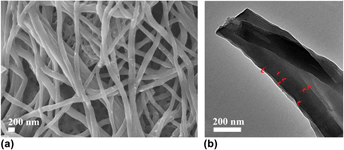Crossref Citations
This article has been cited by the following publications. This list is generated based on data provided by
Crossref.
Jervis, Rhodri
Kok, Matt D. R.
Montagut, Julian
Gostick, Jeff T.
Brett, Dan J. L.
and
Shearing, Paul R.
2018.
X‐ray Nano Computed Tomography of Electrospun Fibrous Mats as Flow Battery Electrodes.
Energy Technology,
Vol. 6,
Issue. 12,
p.
2488.
Tan, Yongtao
Dong, Wenju
Li, Yuan
Muchakayala, Ravi
Kong, Lingbin
Kang, Long
and
Ran, Fen
2018.
MoO2/Mo2N hybrid nanobelts doped with gold nanoparticles and their enhanced supercapacitive behavior.
New Journal of Chemistry,
Vol. 42,
Issue. 22,
p.
17895.
Ran, Fen
Wu, Yage
Jiang, Minghuan
Tan, Yongtao
Liu, Ying
Kong, Lingbin
Kang, Long
and
Chen, Shaowei
2018.
Nanocomposites based on hierarchical porous carbon fiber@vanadium nitride nanoparticles as supercapacitor electrodes.
Dalton Transactions,
Vol. 47,
Issue. 12,
p.
4128.
Li, Yu
Zhao, Liang
Wang, Hao
and
Li, Baohua
2019.
Synthesis of novel shape-stabilized phase change materials with high latent heat and low supercooling degree for thermal energy storage.
Journal of Materials Research,
Vol. 34,
Issue. 19,
p.
3263.
Ma, Shuai
Wang, Yixing
Liu, Zhenying
Huang, Mengnan
Yang, Hu
and
Xu, Zhen-liang
2019.
Preparation of carbon nanofiber with multilevel gradient porous structure for supercapacitor and CO2 adsorption.
Chemical Engineering Science,
Vol. 205,
Issue. ,
p.
181.
Stojanovska, Elena
and
Kilic, Ali
2019.
Carbon nanofibers as thick electrodes for aqueous supercapacitors.
Journal of Energy Storage,
Vol. 26,
Issue. ,
p.
100981.
Punde, Ninad S.
Karna, Shashi P.
and
Srivastava, Ashwini K.
2019.
Supercapacitive performance of a ternary nanocomposite based on carbon nanofibers with nanostructured chitosan and cobalt particles.
Materials Chemistry and Physics,
Vol. 233,
Issue. ,
p.
353.
Wang, Tongtong
Rony, Asif H.
Sun, Kaidi
Gong, Weibo
He, Xin
Lu, Wenyang
Tang, Mingchen
Ye, Runping
Yu, Jiuling
Kang, Lin
Luo, Hongmei
Smith, Steve J.
Eddings, Eric G.
and
Fan, Maohong
2020.
Carbon Nanofibers Prepared from Solar Pyrolysis of Pinewood as Binder-free Electrodes for Flexible Supercapacitors.
Cell Reports Physical Science,
Vol. 1,
Issue. 6,
p.
100079.
Tan, Yongtao
Li, Yuan
Wang, Wenchun
and
Ran, Fen
2020.
High performance electrode of few-layer-carbon@bulk-carbon synthesized via controlling diffusion depth from liquid phase to solid phase for supercapacitors.
Journal of Energy Storage,
Vol. 32,
Issue. ,
p.
101672.
Nie, Guangdi
Zhao, Xinwei
Luan, Yaxue
Jiang, Jiangmin
Kou, Zongkui
and
Wang, John
2020.
Key issues facing electrospun carbon nanofibers in energy applications: on-going approaches and challenges.
Nanoscale,
Vol. 12,
Issue. 25,
p.
13225.
Wang, Tongtong
He, Xin
Gong, Weibo
Sun, Kaidi
Lu, Wenyang
Yao, Yi
Chen, Zhe
Sun, Tongqing
and
Fan, Maohong
2020.
Flexible carbon nanofibers for high-performance free-standing supercapacitor electrodes derived from Powder River Basin coal.
Fuel,
Vol. 278,
Issue. ,
p.
117985.
Orasugh, Jonathan Tersur
Ghosh, Swapan Kumar
and
Chattopadhyay, Dipankar
2020.
Fiber-Reinforced Nanocomposites: Fundamentals and Applications.
p.
199.
Ojha, Gunendra Prasad
Pant, Bishweshwar
Acharya, Jiwan
and
Park, Mira
2021.
An electrochemically reduced ultra-high mass loading three-dimensional carbon nanofiber network: a high energy density symmetric supercapacitor with a reproducible and stable cell voltage of 2.0 V.
Nanoscale,
Vol. 13,
Issue. 46,
p.
19537.
Ma, Chang
Cao, Erchuang
Dirican, Mahmut
Subjalearndee, Nakarin
Cheng, Hui
Li, Junjing
Song, Yan
Shi, Jingli
and
Zhang, Xiangwu
2021.
Fabrication, structure and supercapacitance of flexible porous carbon nanobelt webs with enhanced inter-fiber connection.
Applied Surface Science,
Vol. 543,
Issue. ,
p.
148783.
Li, Xiang-Ye
Yan, Yong
Zhang, Bing
Bai, Tian-Jiao
Wang, Zhen-Zhen
and
He, Tie-Shi
2021.
PAN-derived electrospun nanofibers for supercapacitor applications: ongoing approaches and challenges.
Journal of Materials Science,
Vol. 56,
Issue. 18,
p.
10745.
Tan, Yongtao
Xu, Zhongxiong
He, Lijun
and
Li, Haibo
2022.
Three-dimensional high graphitic porous biomass carbon from dandelion flower activated by K2FeO4 for supercapacitor electrode.
Journal of Energy Storage,
Vol. 52,
Issue. ,
p.
104889.
Abutaleb, Ahmed
and
ArunPrasanna, Vimalanathan
2022.
Fabrication of biopolymer nanofibers from natural sources.
Textile Research Journal,
Vol. 92,
Issue. 9-10,
p.
1694.
Habibi, Milad Kohi
Rafiaei, Seyed Mahdi
Alhaji, Amir
and
Zare, Maryam
2022.
Synthesis of ZnFe2O4: 1 wt% Ce3+/Carbon fibers composite and investigation of its adsorption characteristic to remove Congo red dye from aqueous solutions.
Journal of Alloys and Compounds,
Vol. 890,
Issue. ,
p.
161901.
Samanta, Arpita Priyadarshini
Ali, Mir Sahidul
Orasugh, Jonathan Tersur
Ghosh, Swapan Kumar
and
Chattopadhyay, Dipankar
2022.
Crosslinked nanocollagen-cellulose nanofibrils reinforced electrospun polyvinyl alcohol/methylcellulose/polyethylene glycol bionanocomposites: Study of material properties and sustained release of ketorolac tromethamine.
Carbohydrate Polymer Technologies and Applications,
Vol. 3,
Issue. ,
p.
100195.
Orasugh, Jonathan T.
Pal, Chandrika
Samanta, Arpita P.
and
Chattopadhyay, Dipankar
2022.
Encyclopedia of Materials: Plastics and Polymers.
p.
837.



